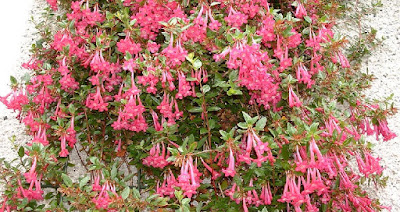 |
| Echium wildpretii |
Echium is a genus of approximately 60 species of hardy and half hardy annuals and biennials, however it is the tall flower spikes of the commonly called 'Tree echiums' which most capture the imagination.
 |
| Echium pininana |
Native to the Canary islands (except for Echium candicans which is native to the island of Madeira), tree Echiums are easily identified by their growth habit, which in their first year is expressed by a low rosette of silver, hairy, spear-like leaves. In the second year, the plant suddenly spurts into rapid growth and produces a single, occasionally multistem (especially if the growing tip has been subject to damage - usually caterpillar), tall flower spike festooned with blue or pink flowers depending on the species or cultivar. Once the flowers have finished then the plant will die off. However, Echium seeds are particularly viable, and are produced in large quantities.
 |
| Echium simplex |
Newly planted specimens will require plenty of water during their first few weeks to help them establish. Firm the soil around the base of the plant and provide a sturdy stake in exposed positions. Be aware that tree echiums tend to bend at the base of the stem under their own weight and can easily become pushed over in strong winds.
In regions which experience freezing conditions cover plants with a horticultural fleece over the winter. Spray with an insecticide beforehand as foliage-eating insects and caterpillars will also enjoy spending the winter under protection.
For related articles click onto the following links:
ECHIUM PININANA
HOW TO GROW TREE ECHIUMS
HOW TO GROW ECHIUM FROM SEED
HOW TO GROW ECHIUM WILDPRETII
HOW TO GROW LOTUS BERTHELOTII
HOW TO GROW PUYA RAIMONDII FROM SEED











































